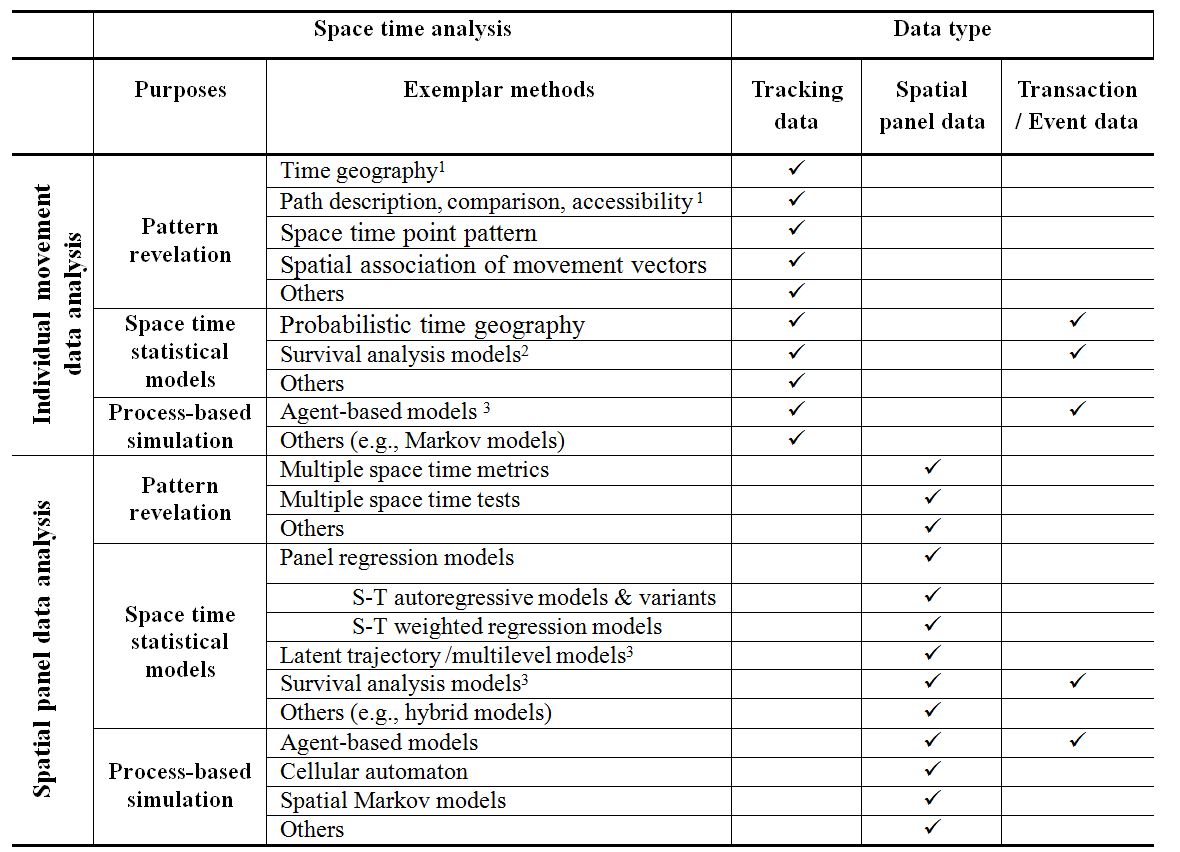Methodology: Space-Time Analysis (S-T Analysis)
Space-time analysis has become a buzzword in the last decade or so. What really is it? Largely speaking, space-time analysis aims to answer questions of both "when" and "where" things occur, and sometimes, why things occur at locations or times of interest. Interest in space-time analysis can date to early stage of human history as a certain thing of interest (e.g., an event or a phenomenon) often had to be associated with a space and a time. However, since the 1990s, the number of publications about space-time analysis has exploded (An et al. 2015), signaling the advent of an era of space-time analysis.
Based on a literature review, An et al. (2015) have raised a typology of space-time analysis, which classifies various methods, models, and tools into two types: one for individual movement data analysis and one for spatial panel data analysis. Under each type, models can be largely labeled as pattern revelation models, space-time statistical models, and process-based simulation models. More details see the table below (from An et al. 2015).
 The CHES group has been advocating and advancing two very important space-time analysis models: latent trajectory models connecting to eigenvector spatial filtering (LTM-ESF; An et al. 2016, Crook et al. 2016) and landscape survival analysis (LSA; An et al. 2008, 2011). Also through developing 4-D ABM, the CHES group is making space-time analysis more robust in visualizing, explaining, and envisioning human-landscape processes. Below are papers for generic knowledge of space-time analysis.
The CHES group has been advocating and advancing two very important space-time analysis models: latent trajectory models connecting to eigenvector spatial filtering (LTM-ESF; An et al. 2016, Crook et al. 2016) and landscape survival analysis (LSA; An et al. 2008, 2011). Also through developing 4-D ABM, the CHES group is making space-time analysis more robust in visualizing, explaining, and envisioning human-landscape processes. Below are papers for generic knowledge of space-time analysis.
Readings and References:
An, L., M. Tsou, B. Spitzberg, J.M. Gawron, and D.K. Gupta (2016). Latent trajectory models for space-time analysis: An application in deciphering spatial panel data. Geographical Analysis (see the link below for "The LTM-ESF Paper").
An, L., and S. Crook (2016). Spatiotemporal analysis. Entry for The International Encyclopedia of Geography: People, the Earth, Environment, and Technology. Section editor: Mei-Po Kwan; general editor: Michael Goodchild.
An, L., M. Tsou, S. Crook, B. Spitzberg, J.M. Gawron, and D.K. Gupta (2015). Space-time analysis: Concepts, quantitative methods, and future directions. Annals of Association of American Geographers 105(5):891-914.
An, L., D. G. Brown, J. Nassauer, and B. Low (2011). Variations in development of exurban residential landscapes: Timing, location, and driving forces. Journal of Land Use Science.6 (1): 13–32.
An, L., and D. G. Brown (2008). Survival analysis in land-change science: integrating with GIScience to address temporal complexities. Annals of Association of American Geographers 98(2): 323-344.
Crook, S.E.S., L. An, D.A. Stow, and J.R. Weeks (2016). Latent trajectory modeling of spatiotemporal relationships between land cover and land use, socioeconomics, and obesity in Ghana. Spatial Demography 4(3): 221-244 (DOI 10.1007/s40980-016-0024-6).
Yuan, M., A. Nara, and J. Bothwell (2014). Space–time representation and analytics. Annals of GIS 20 (1): 1–9.
Models and Examples:
See this page for specific models, methods, and the related documentations.
Lorem ipsum dolor sit amet, consectetur adipiscing elit. Proin aliquam eros eget dolor cursus eleifend. Sed vel tortor vitae augue auctor convallis id nec mauris. Fusce scelerisque leo et magna sagittis, vitae dapibus mi tempor. Quisque dolor tellus, tristique vel dolor vel, laoreet efficitur ligula.
- Link
- Link
- Link
- Link
